The Art of Pain
The Common Vein Copyright 2008
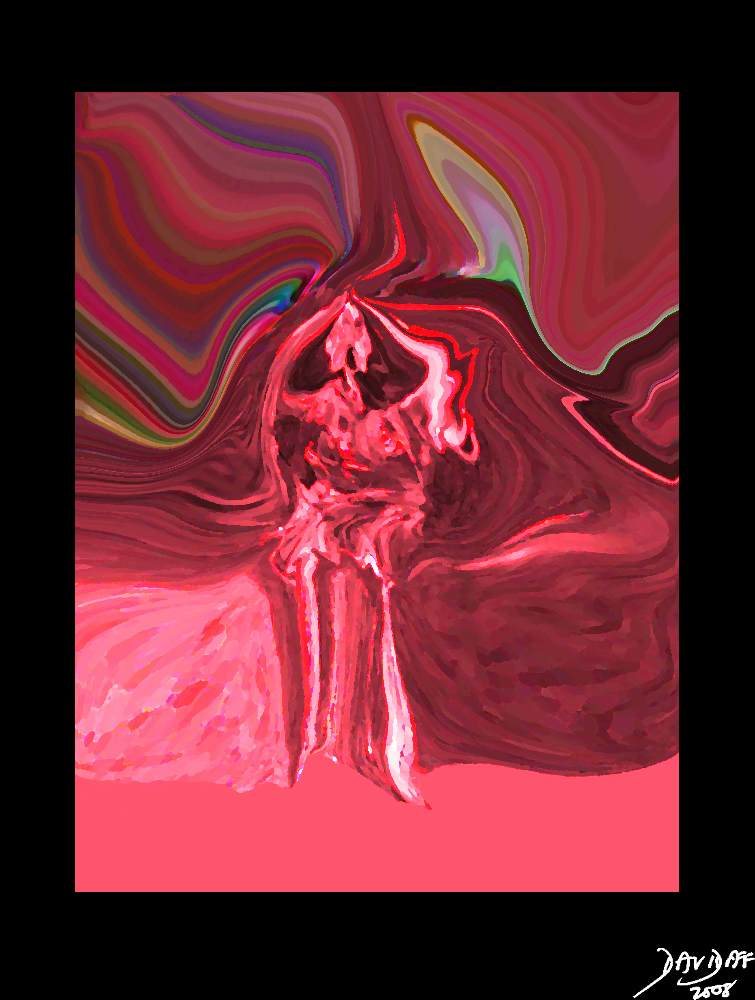 Explosive Excruciating and Blinding Headache Explosive Excruciating and Blinding Headache
“Awakened with the Worst Pain in My Life” |
| This is the pain that rattles emergency room physicians as they know the diagnosis to exclude is the potentially fatal condition of a ruptured berry aneurysm in the cerebral circulation. The pain is unbearable for the patient and is a somatic pain caused by blood irritating the meninges.
89081pd04b07.8s pain headache sleep woken awakened from sleep worst pain in my life headache 10 out of 10 ruptured berry aneurysm bleed blood hemorrhage meninges somatic Davidoff art copyright 2008 |
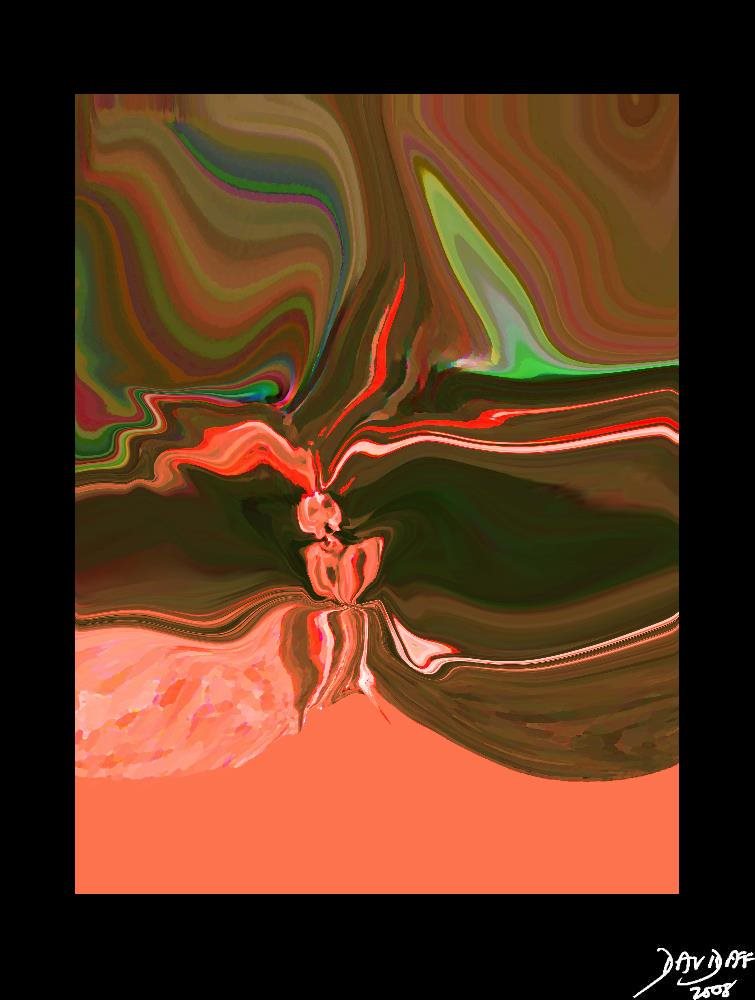 Severe Abdominal Pain Severe Abdominal Pain |
| 89081pd04b09.8s pain abdomen sleep woken awakened from sleep somatic peritoneal peritonitis Davidoff art copyright 2008 |
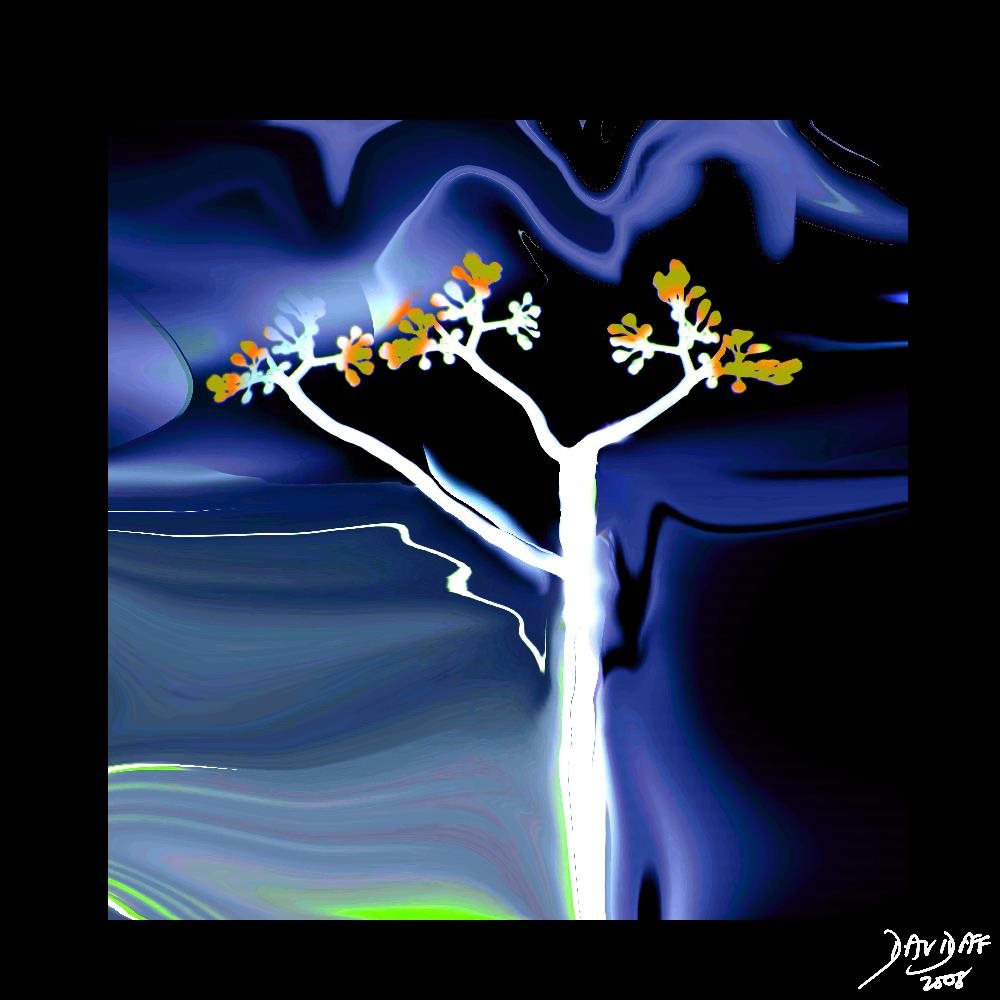 Nociceptors Nociceptors |
| 87559pb04b07b.8s tree in bud nociceptors free nerve endings trees in the body Davidoff art copyright 2008 |
| Headache – Above the Eyes Above the Ears and Behind the neck |
|
74771c06.8 head and neck pain headache abve the eyes above the ears CTscan volume rendering 3D Courtesy Ashley Davidoff MD |
Duration of Pain
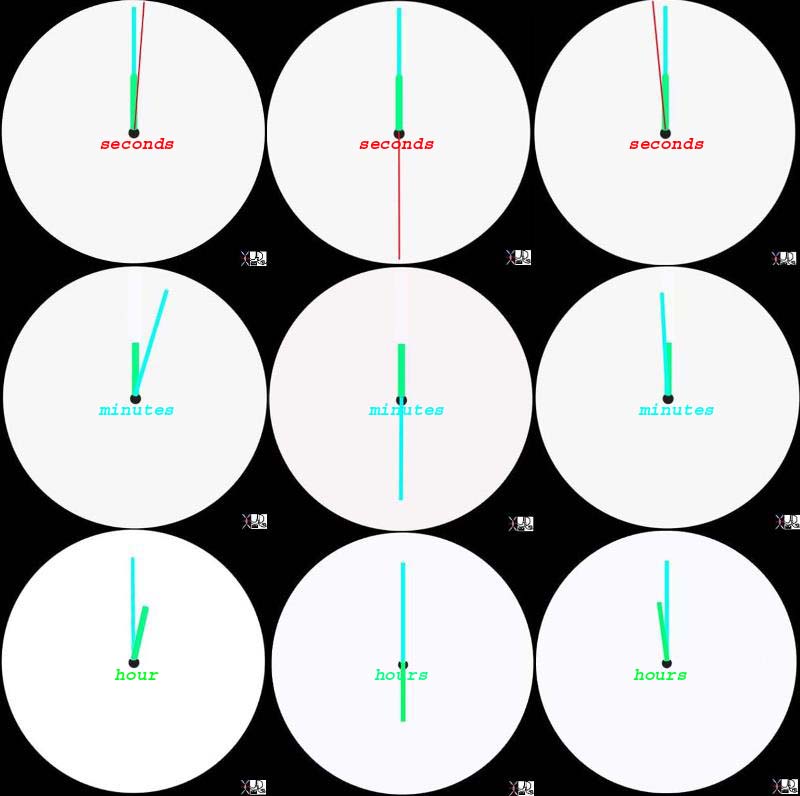 Seconds Minutes and Hours Seconds Minutes and Hours |
| 77118c.81 time clock duration seconds minutes hours Davidoff art Courtesy Ashley Davidoff MD |
 Days and Weeks Days and Weeks |
| 77119b01 time duration age Monday Tuesday Wednesday Thursday Friday Saturday Sunday Davidoff Art Copyright 2008 Courtesy Ashley Davidoff MD |
 Months and Seasons Months and Seasons |
| 77119b04 time months seasons age one year colors white = cold light pink = early spring pink = early summer green = early summer blue = summer pale yellow = mid summer bright yellow = late summer orange = early fall brown = late fall dark gray = early winter light gray = winter white = mid winter very light pink = late winter Davidoff Art Courtesy Ashley Davidoff MD |
Severity of Pain
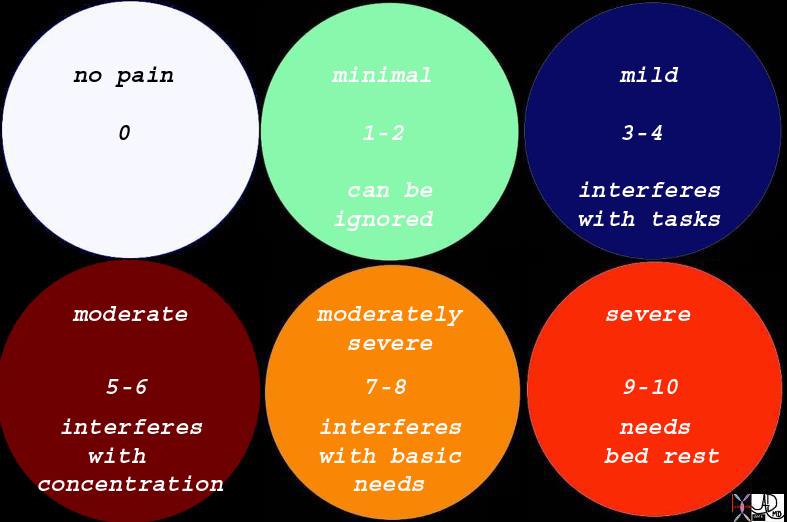 Modification of the Wong Baker Scale Modification of the Wong Baker Scale |
| 77114c.88 Davidoff pain scale modification Wong Baker no pain minimal mild moderate moderately severe severe ignored interferes with tasks interferes with concentration interferes with basic needs needs bed rest white green blue maroon orange red Davidoff art Courtesy Ashley Davidoff MD |
| Paranasal Sinuses |
| This CT shows a reconstruction of the face with attention to the air filled structures. Of particular interest to headache are the paranasal sinuses . The maxillary sinuses are overlaid in orange while the ethmoid sinuse and the more posterior sphenoid sinuses cannot be separated in this anteroposterior view (green). Lastly the frontal sinuses are seen overlaid in dark orange just above the orbits. Other sources of pain demonstrated in this image include the eyes and obits, the ears, mouth teeth and pharynx, and ears
48729c02 head and neck face nose ears eustachian tubes concha nasopharynx oropharynx mastoid air cells air filled structure maxillary sinus air filled structure maxillary sinus paranasal sinuses light orange = maxillary sinuses green = combination of ethmoid sinuses and sphenoid sinuses dark orange = frontal sinuses normal anatomy CTscan 3D volume rendering Courtesy Ashley Davidoff MD |
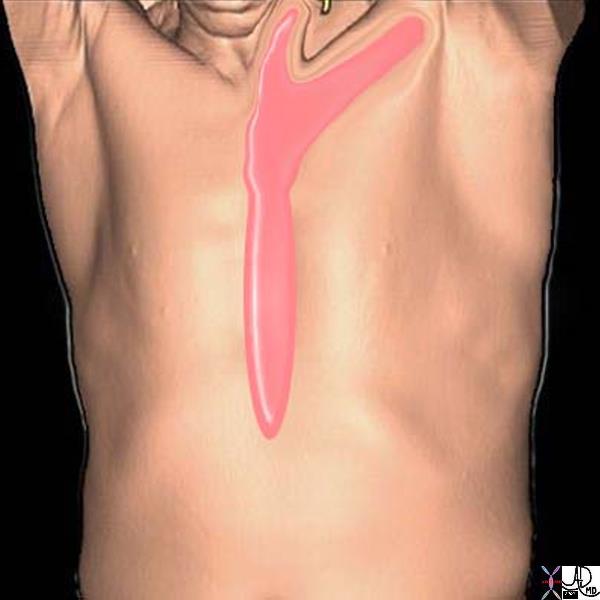 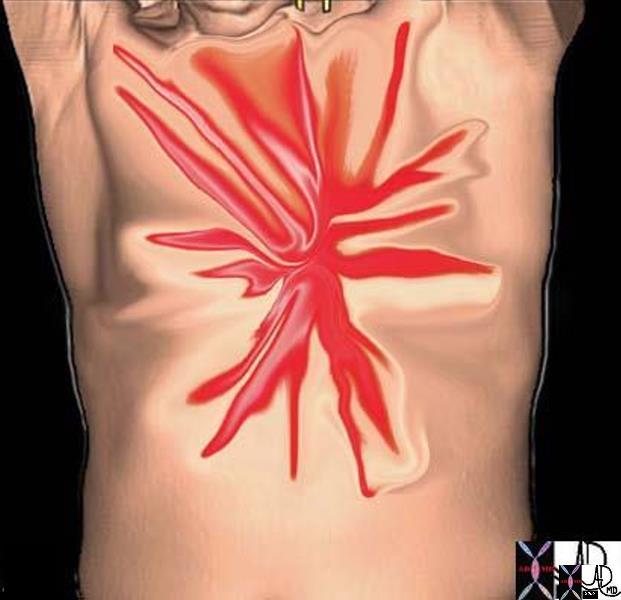 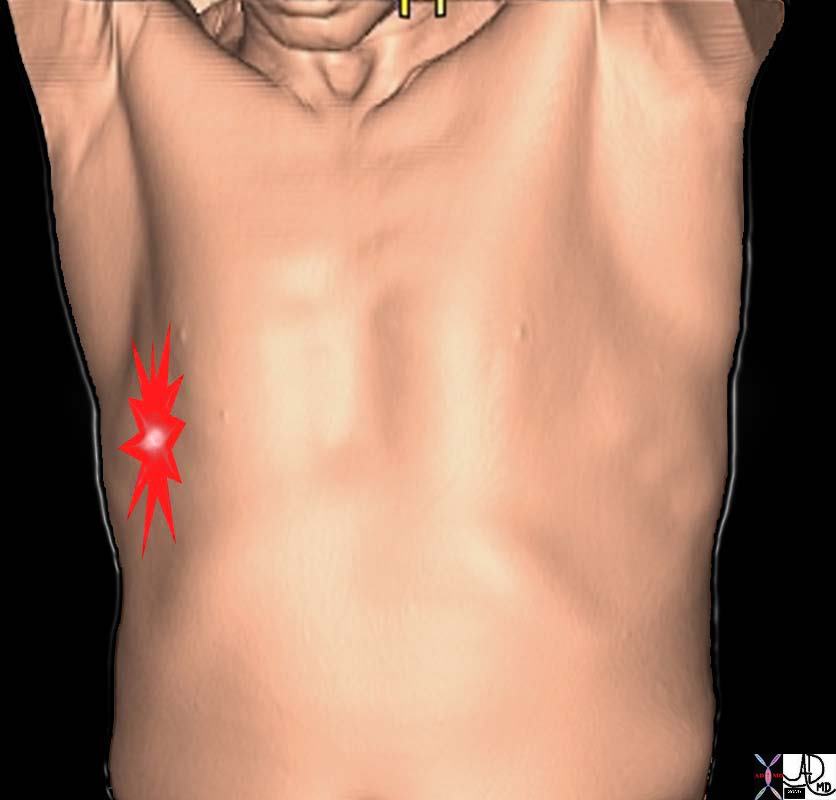 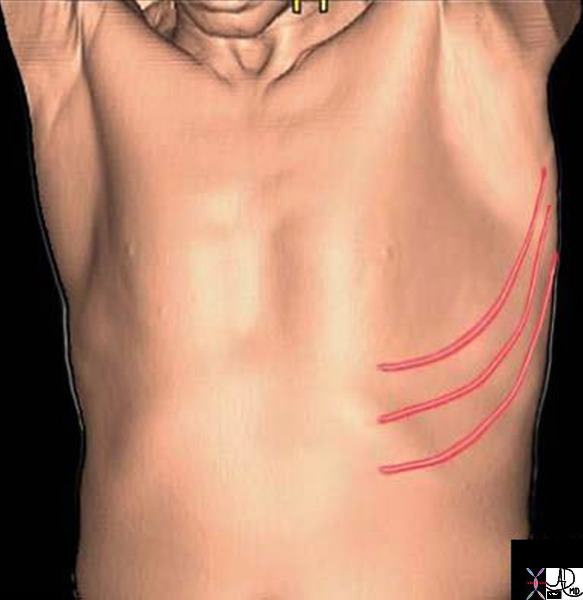 Characteristics of Chest Pain Characteristics of Chest Pain |
| In the above diagram and through the text, we attempt to depict the nature of the pain diagramatically. The more severe pains are shown in brighter red and the spiculated shapes reflect sharper pain. Thus the top left image is severe burning retrosternal pain characteristic of GERD with esophagitis. The top middle image is a pressure type pain that radiates o the neck, characteristic of angina and sometimes seen in esophageal spasm. The top right image is a more diffuse discomfort or pressure and is seen in angina and myocardial infarction. The bottom left image is sharp lancinating severe almost devastating pain characteristic of acute aortic dissection. The focal sharp pain in the middle image aggravated by deep inspiration is characteristic of pleuritc pain and pericarditis, whil the pain along a dermatome on bottom right is seen in herpes zoster (shingles).
71197c05a 71197c07a 42540c02a05 71197c08a 71197b03p 71197c04a Davidoff Art Courtesy Ashley Davidoff MD Copyright 2008 |
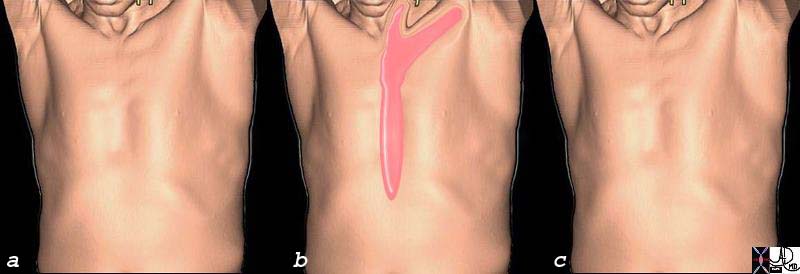 Stable Angina – Predictable Patterns Stable Angina – Predictable Patterns
a) No pain – excercise b) Pain Pressure Typical Distribution c) Relieved by Rest, TNG |
| Angina is characteristically a dull pressure like pain, that is precipitated by stress usually after a predictable distance of a walk or run for example. In a, the patient has no discomfort, develops pain after a fixed distance, and then stops. The pain is relieved
71197c07c substernal chest pain burning esophagus heart cardiac esophagitis reflux substernal chest pain radiating to neck and left arm relieved by rest and sublingual nitroglycerine angina CTscan 3D Courtesy Ashley Davidofff MD |
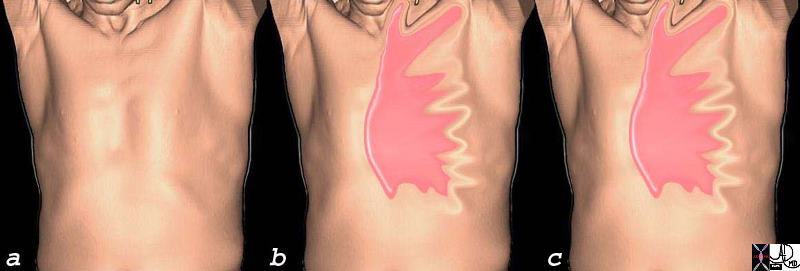 Acute Coronary Syndrome Acute Coronary Syndrome
(a )is prior to the event, (b) Sudden Severe Pain Pressure Discomfort (c) Unrelieved by TNG and Rest and 1 hour later |
| In the diagram above, image a represents the patient without pain before the event. Sudden and evolving chest discomfort or pressure with radiation to the neck and left arm occurs (b) that is not relieved with nitroglycerine, and remains for longer than 20 minutes (c) suggests an acute coronary syndrome.
71197c08c.800 substernal chest pain burning esophagus heart cardiac esophagitis reflux retrosternal chest pain radiating to neck and left arm unrelieved by rest and sublingual nitroglycerine myocardial infarction time hours CTscan 3D Davidof art Courtesy Ashley Davidofff MD |
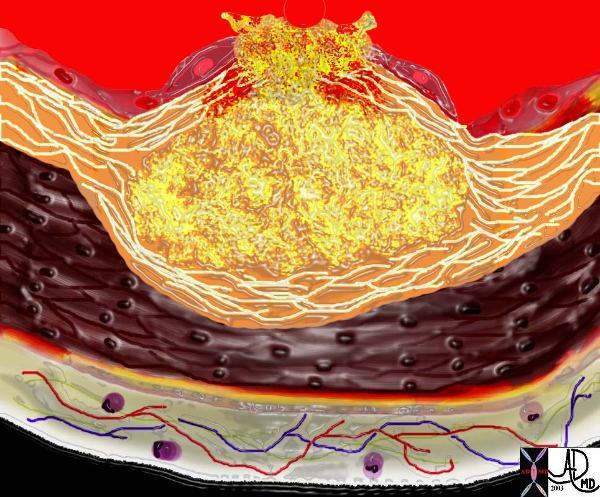 A Ruptured Atherosclerotic Plaque A Ruptured Atherosclerotic Plaque |
| This diagram shows denudation of the endothelial layer with exposure and rupture of the contents of the atherosclerotic plaque in volcanic fashion into the lumen. This event is catastrophic and can result in acute thrombosis and may even be a fatal event.
33801d Courtesy Ashley Davidoff MD. code heart artery atherosclerosis atheroma vulnerable plaque drawing Davidoff art |
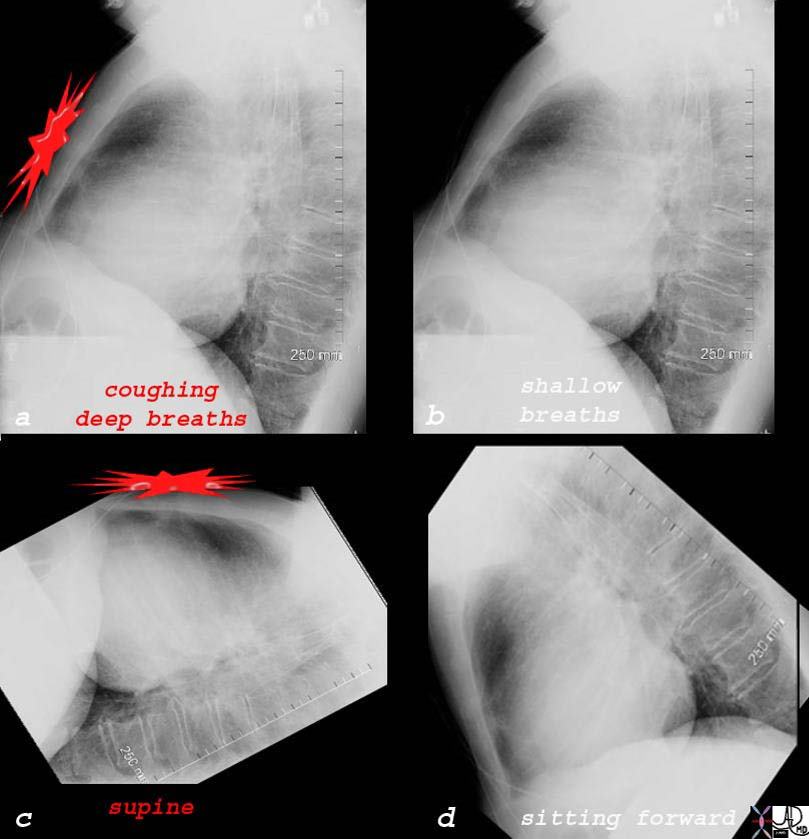 Aggravating and Relieving Characteristics of Pain from Pericarditis Aggravating and Relieving Characteristics of Pain from Pericarditis |
| The most characteristic feature of the pain of pericarditis is that it is relieved by sitting up or forward. Image a shows the characteristic sharp pain occurring in the precordium, as being intense and pleuritic in nature aggravated by coughing and deep breathing but relieved by sitting up, and shallow breathing (b). The pain is also aggravated by lying down, (c) but is relieved by sitting forward (d)
76031c01d02 chest heart pericardium pain aggravated by coughing and deep breathing relieved by shallow breathing and sitting forward acute pericarditis pericardial effusion lateral chest X-ray plain X-ray Courtesy Ashley Davidoff MD |
|
|
| This image is intended to reflect the severe (bright red) lancinating, sharp, thunderbolt like character (spiculated shape) of the chest pain that the patient with acute dissection may experience. One moment the patient is healthy without symptoms (a) and the next, there is catastrophic pain that reaches maximum intensity at the time of onset. (b) This is one of the pain syndromes in medicine one fears. It represents the one of the most severe forms of chest pain one can experience.
71197c10c chest pain character shearing sharp lancinating acute aortic syndrome aortic dissection penetrating ulcer acute aortic hematoma ruptured aorta ruptured dissection CTscan davidoff Art Courtesy Ashley Davidoff MD 49640c06 |
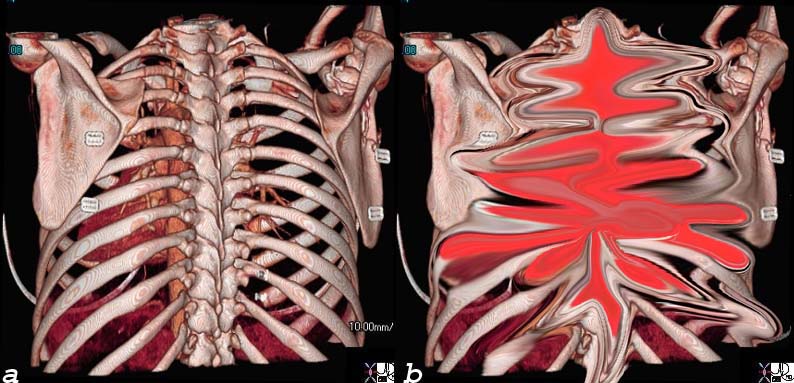 Lancinating Shearing Back Pain of Acute Aortic Syndrome Lancinating Shearing Back Pain of Acute Aortic Syndrome |
| The pain of dissection may be felt either in the front of the chest and or the back. Either way the pain can have similar characteristics – ie sharp, thunderbolt like, severe, and rapidly and almost instantaneously reaching maximum intensity coincident with the onset.
but can 49640c06 chest pain character shearing sharp lancinating acute aortic syndrome aortic dissection penetrating ulcer acute aortic hematoma ruptured aorta ruptured dissection CTscan Courtesy Ashley Davidoff MD |
|
Searing Chest or Back Pain of Acute Aortic Syndrome |
| 49640c06 chest pain character shearing sharp lancinating acute aortic syndrome aortic dissection penetrating ulcer acute aortic hematoma ruptured aorta ruptured dissection CTscan Courtesy Ashley Davidoff MD |
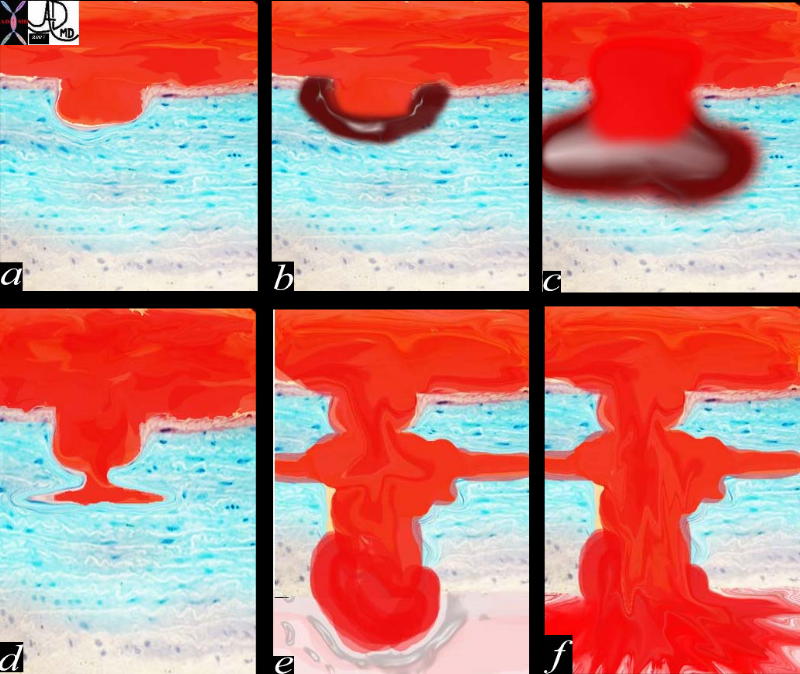 Pathogenesis of Penetrating Diseases of the Aorta and Acute Aortic Syndrome Pathogenesis of Penetrating Diseases of the Aorta and Acute Aortic Syndrome |
| The lumen of the aorta with blood is demonsrated in red. The intima of the wall is the thin light pink layer just under the red lumenal layer. The media or elastic layer is in teal, while the outer layer is a light yellow color (a)
This diagram illustrates the progression from a ulcerated plaque (a), to a mural hematoma(b). The ulcer in c has penetrated the into the media itself and is called a pentrating ulcer with a mural hematoma. (c). In d, a smal focal dissection with flowing blood is seen, and this can either thrombose or progress to a full dissection(e) or penetrate through the wall and be contained (e) or eventually rupture into the mediastinum (f)
42409c01.800 aorta artery atherosclerosis atheroma acute aortic syndrome a aortic ulcer b = acute mural hematoma c = acute mural hematoma large d = focal dissection e penetrating ulcer f rupture histology histopathology Davidoff art pathogenesis Courtesy Ashley Davidoff MD |
 Pleuritic Chest Pain Pleuritic Chest Pain |
| The pleuritic pain demonstrated on the right side of this patient is characterized by focal intense (bright red) and sharp pain that is aggravated by deep breaths and by coughing. The location corresponds to the disease and to the images described below.
71197b03p chest lung pleura pleuritic pain PE pulmonary Embolus pneumonia pleurisy aggrrvated by deep inspiration coughing rib fracture pleuritic pain pleurisy CTscan 3D Courtesy Ashley Davidoff MD |
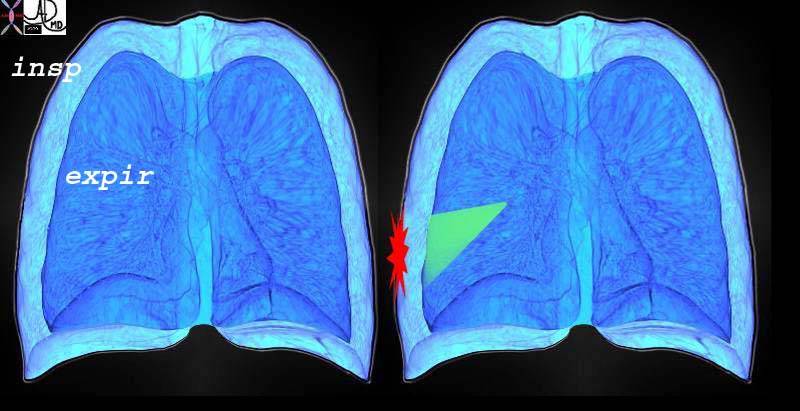 Sharp Intense Pleuritic Pain on Inspiration Due to Pulmonary Embolus and Pulmonary Infarction Sharp Intense Pleuritic Pain on Inspiration Due to Pulmonary Embolus and Pulmonary Infarction |
| This diagram re-enforces the concept of the pleuritic pain being related to respiratory movements and is focal and overlying the disease process. The outer part of the diagram represents the expanded lung of inspiration and the inner less voluminous lung represents the deflated lung of expiration. The green wedge represents the infarcted are of lung from the pulmonary embolus that abuts and involves the visceral and parietal pleura.
42540c02d lung inspiration expiration pain on inspiration focal severe pain pleuritic pain PE pulmonary embolus Davidoff art Courtesy Ashley Davidoff MD |
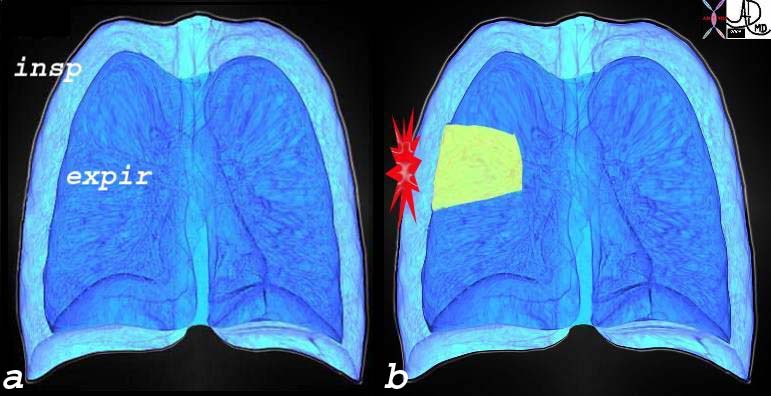 Sharp Intense Pleuritic Pain on Inspiration Due to Peripheral Based Pneumonia Sharp Intense Pleuritic Pain on Inspiration Due to Peripheral Based Pneumonia |
| The pleuritic pain of pulmonary embolus, pneumonia or pleurisy is not distinct in itself, but the associated findings relating to the specific disease will help differentiate the variety of causes of pleuritic chest pain.periphral based pneumonia abuts the pleural surface and parapneumonic pleural inflammation involves both the visceral pleura and the parietal pleura. When the lung moves with respiration the rubbing of inflammed structures and particulalrly the pleura brings about the sharp focal pleuritic pain localized over the pneumonia.
In this instance a 42540c02a01 lung inspiration expiration pain on inspiration focal severe pain pleuritic pain PE pulmonary embolus Davidoff art Courtesy Ashley Davidoff MD |
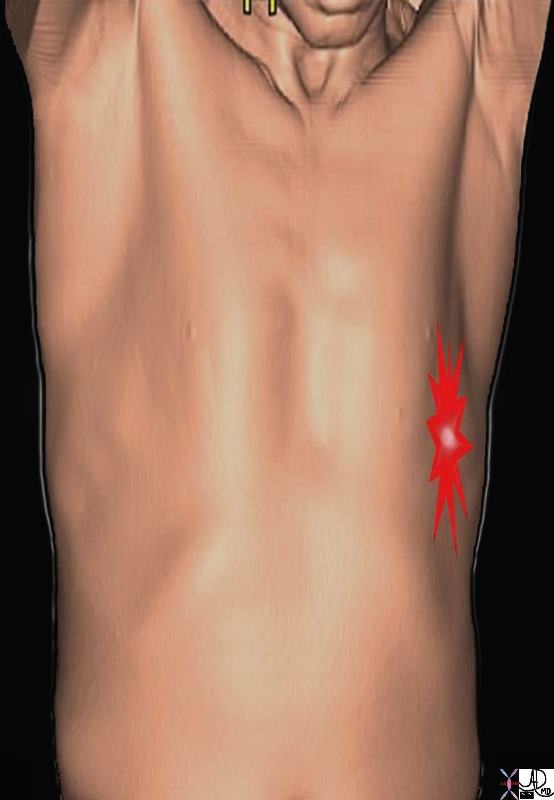 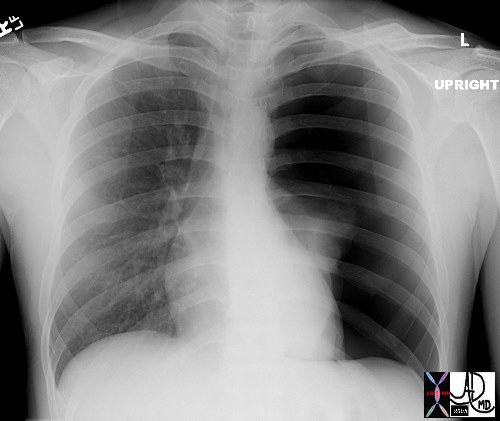 Tall ThinYoung – Spontaneous Pneumothorax with Mediastinal Shift Tall ThinYoung – Spontaneous Pneumothorax with Mediastinal Shift |
| This is the type of CXR that sends shivers down the spine. The overall blackness of the left chest cavity, in association with a nubbin of lung tissue in the ipsilateral hilum and rightward mediastinal shift is characteristic of a tension pneumothorax with total atelectasis of the left lung. Immediate and urgent decompression with a chest drain is indicated. One must also remeber that if a tall thin young patient presents with chest pain the diagnosis of dissecting aneurysm in a patient with Marfans syndrome has to be considered.
Courtesy Ashley Davidoff MD 42525 code lung pleura dx tension pneumothorax plain film CXR 5star medical students |
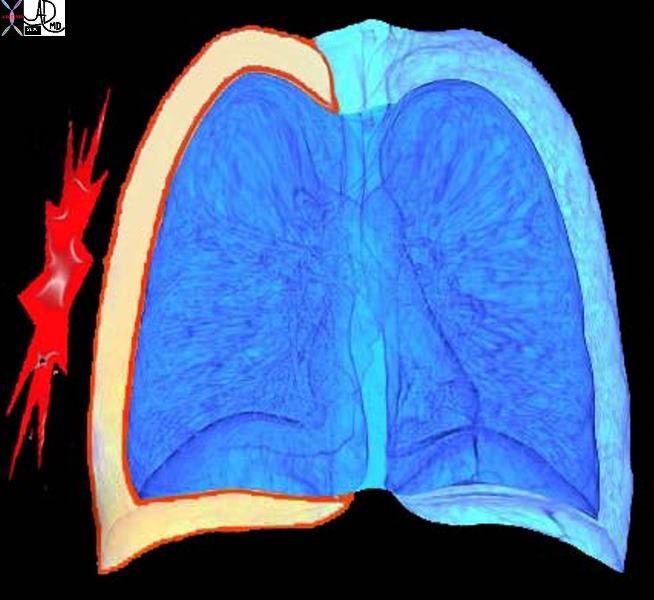 Pleuritic Pain and Effusion – Pleurisy Pleuritic Pain and Effusion – Pleurisy |
| The pleuritic pain is sharp, severe, and aggravated by deep breathing and coughing and relieved by shallow breathing and lying ipsilateral side down. The image on the right shows an overall increase in density of the right chest suggestive of a pleural effusion which is non specific and may accompany many of the diseases discussed.
42540c08 44665 pleural effusion chest lung pleura pleuritic pain pleurisy Davidoff Art Courtesy Ashley DAvidoff MD |
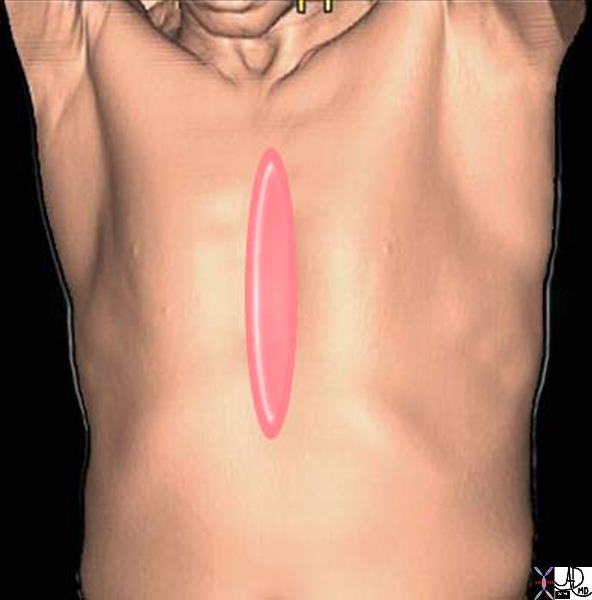 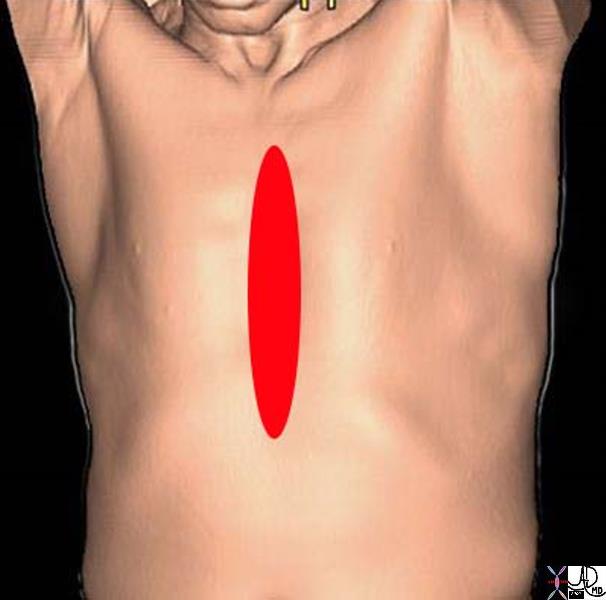 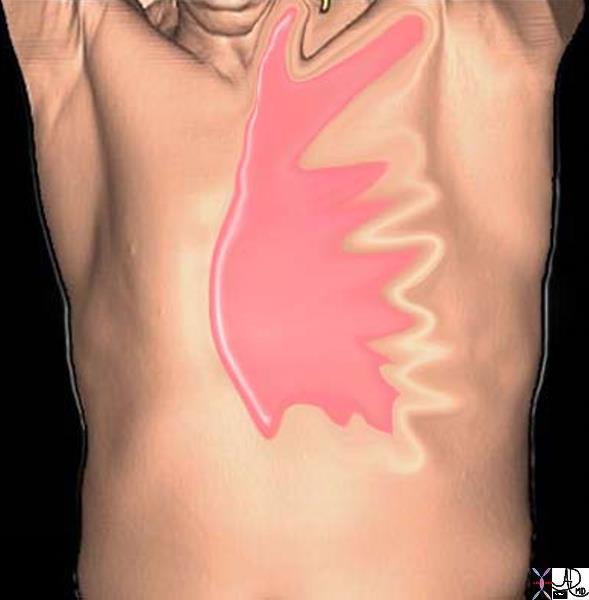 Dull Pain, Burning Sensation, and Angina-like symptoms Dull Pain, Burning Sensation, and Angina-like symptoms
GERD |
| GERD with or without esophagitis and spasm can often masquerade as cardiac pain varying from substernal discomfort, and pressure like symptoms, to substernal pain and burning (b) to discomfort that radiates to the neck and shoulder (c) but also is sometimes relieved by nitroglycerine. The pain however is not precipitated by excercise nor relieved by rest.
71197c06a 71197c05a substernal chest pain burning esophagus heart cardiac esophagitis reflux angina MI myocardial infarction subsernal chest pain CTscan 3D Courtesy Ashley Davidofff MD |
 Pain Relieved by nitroglycerine- Unrelated to Excercise and Rest Pain Relieved by nitroglycerine- Unrelated to Excercise and Rest |
| The diagram illustrates a patient without pain (a) who develops substernal pain radiating to the neck and left shoulder. He takes nitroglycerine and the pain is relieved. (c) The pain was however not related to excercise and was not relieved by rest and lasted 10 minutes. Wht is the most likely cause of the pain? Sometimes esophageal spasm associated with GERD can respond to nitroglycerine and this is th most likely diagnosis. The patient however should undergo a stress test to ensure that he does not have ischemic heart disease.
71197c07c substernal chest pain burning esophagus heart cardiac esophagitis reflux substernal chest pain radiating to neck and left arm relieved by rest and sublingual nitroglycerine angina CTscan 3D Courtesy Ashley Davidofff MD |
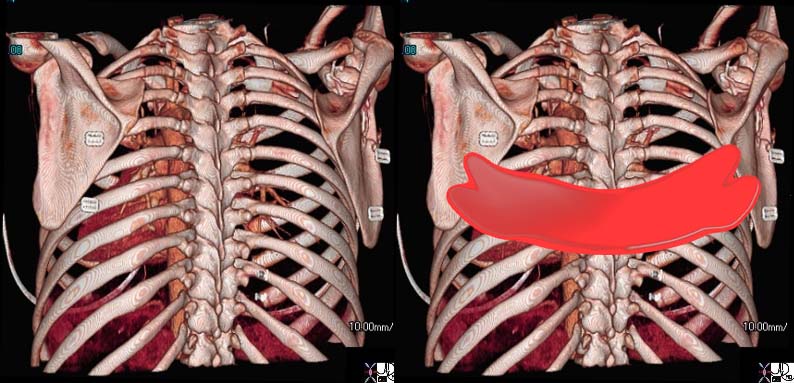 Band Like Interscapular Pain Band Like Interscapular Pain |
| The interscapular band like back pain is part of both lower chest and upper abdominal disease.
49640c03 chest back pain belt interscapular band like pancreas gallbladder retroperitoneum retroperitoneal structures CTscan Courtesy Ashley Davidoff MD 3D |
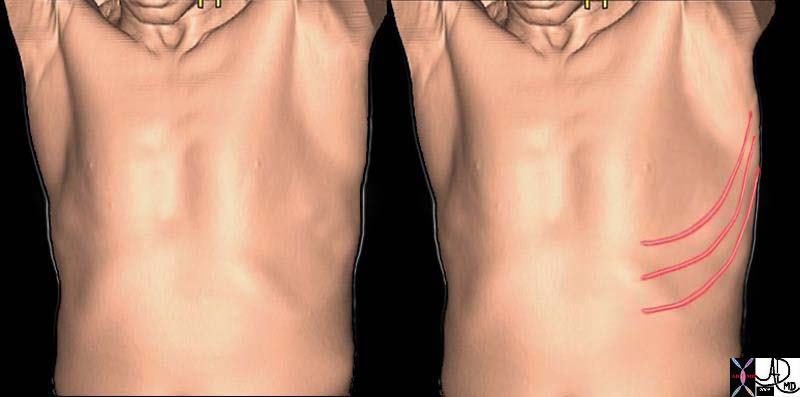 Dermatomal Pain Dermatomal Pain |
| Pain that distributes along a dermatome is characteristic of Herpes Zoster (aka shingles) The dermatomes involved are usually thoracic and between one and 3 dermatomes are involved with burning and sometimes severe pain associated with a rash with vesicles.
71197c04 skin chest pain dermatome pain herpes anatomy CTscan 3D volume rendering Courtesy Ashley Davidoff MD |
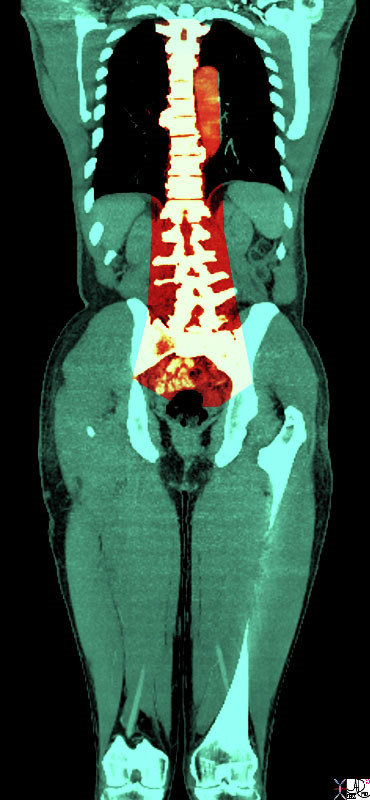 Anatomic Distribution of Back Pain Anatomic Distribution of Back Pain |
| 48390.83 bone back pain spine lumbar spine thorax thoracic cage pancreatitis aortic syndrome CTscan Courtesy Ashley Davidoff MD |
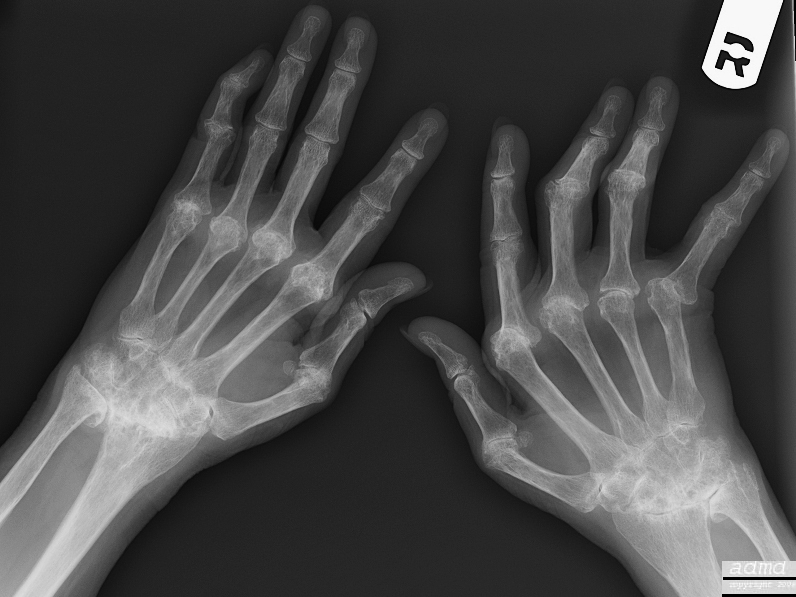 Rheumatoid Arthritis – Painful to Look at! Rheumatoid Arthritis – Painful to Look at! |
| The classical fetures with severe arthritis, involving the proximal interphalangeal joints and the carpal joints with resulting ulnar deviation and severe osteopenia are charcateristic features of rheumatoid arthritis. Neck pain in a patient with this entity requires an alertness of associated involvement of the cervical spine and the most serious involvement is related to the C1-C2 joint.
75627.800 bones hands carpal metacarpal interphalangeal joints erosions ulnar deviation joint space loss osteopenia arthritis RA rheumatoid arthritis inflammation shape position wrists plain X-ray plain film Courtesy Ashley Davidoff MD |
 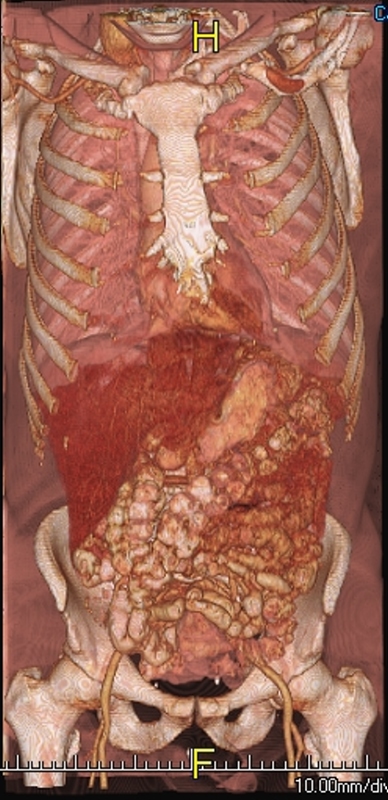 Quadrants of the Abdomen Quadrants of the Abdomen |
| 49703b19 71203.800 chest abdomen pelvis sternum bone ribs iliac crest femur femoral neck pubic symphisis ischium ischial tuberosity scapula clavicle lung heart pericardium liver stomach small bowel colon femoral artery normal anatomy CTscan 3D surface rendering Courtesy Ashley Davidoff MD |
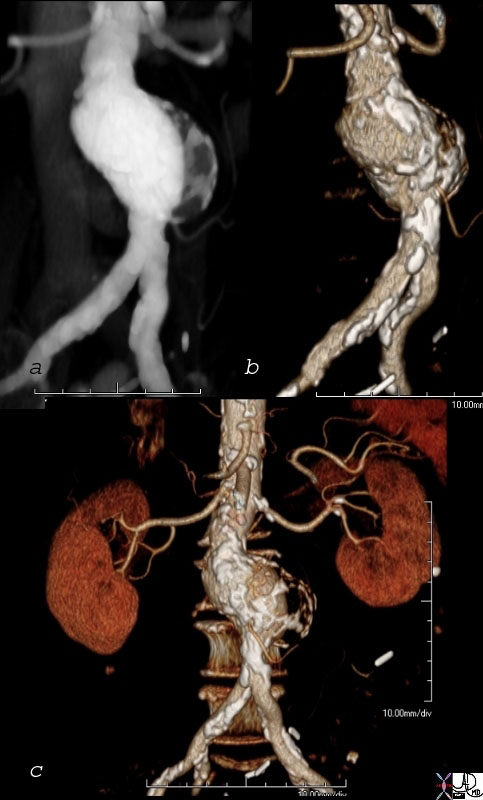 Abdominal Aortic Aneurysm Abdominal Aortic Aneurysm |
| 74089c01 aorta abdominal aorta enlarged aneurysmal surface rendering calcifications 5.2cms AAA 3D CTscan Courtesy Ashley Davidoff MD |
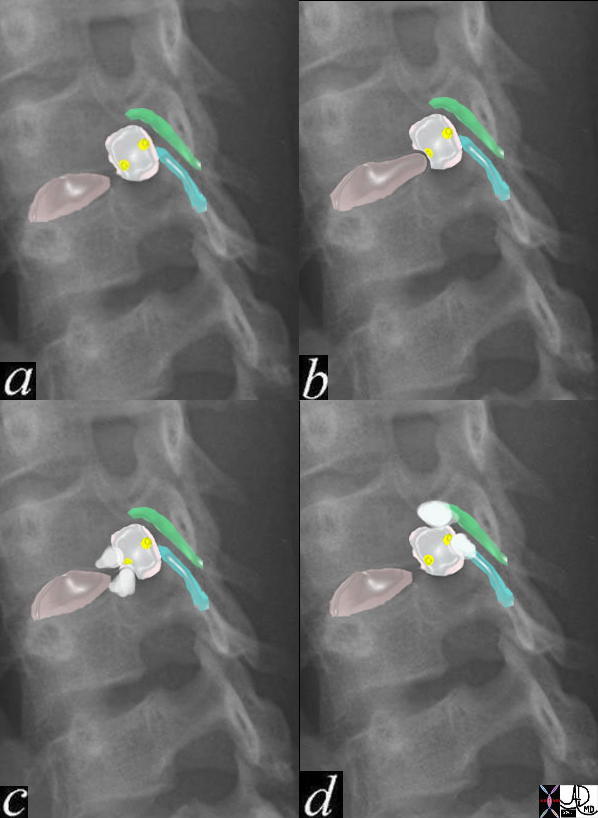 Key Elements Relating to Many Causes of Back Pain Key Elements Relating to Many Causes of Back Pain |
| The oblique projection of the plain film of the spine exposes the neural foramen with its pair of nerves (yellow) and intervertebral disc(a) and shows the intimate relationship between the disc, the nerves and the facet joints. The second image (b) shows the disc impinging on the nerve, while image c shows osteophytes from the vertebral bodies impinging on the nerves and foinally image d shows the effect of osteophytes of the facet joints impinging.
71741b07c01 a) = normal b) = disc protrusion c) = ostephytes off the vertebral bodies d) = osteophytes off the facet joints bone spine facet joints pedicles oblique spine intervertebral disc spaces vertebral body vertebral body osteophytes DJD degenerative disc joint disease nerve impingement pedicles neural forammen nerves plain X-ray Courtesy Ashley Davidoff MD |
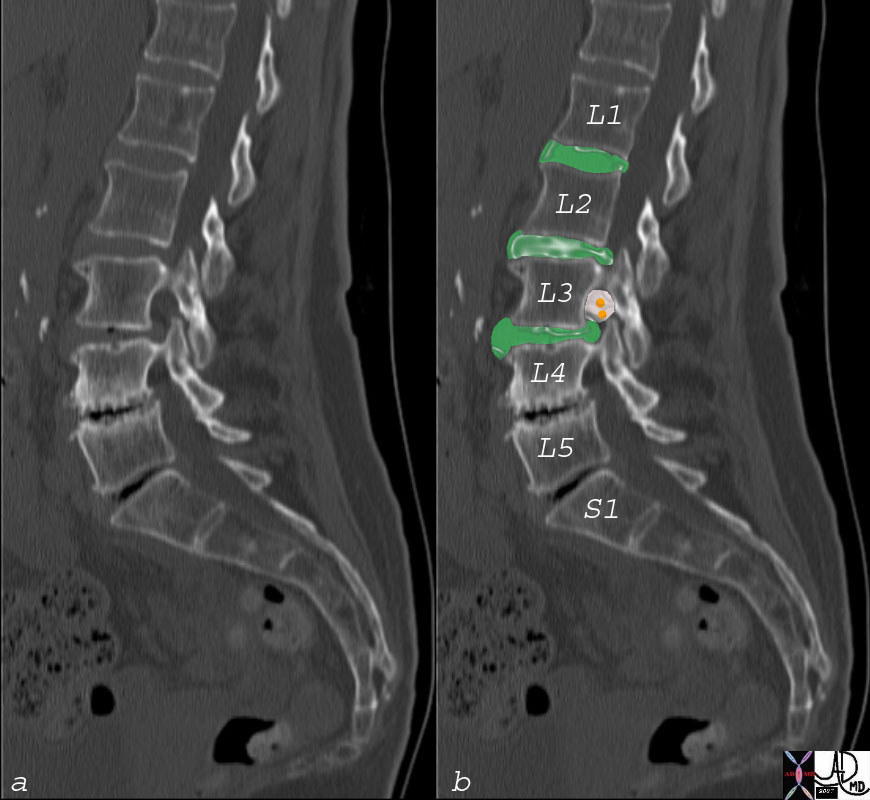 75018c02 75018c02 |
| 75018c02 bone lumbar spine disc disease with disc herniation intervertebral disc space narrowing vacuum phenomenon sclerosis CTscan Courtesy Ashley Davidoff MD |
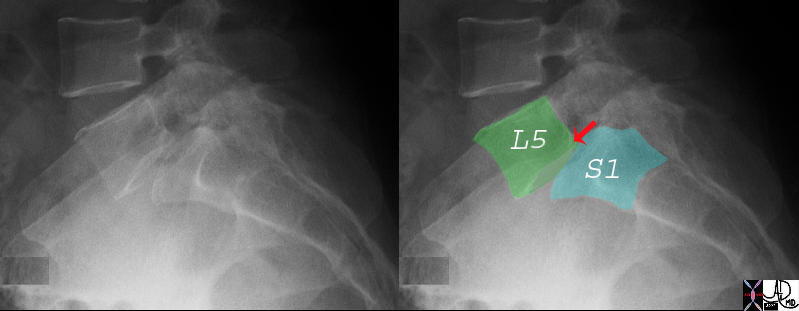 Forward Slippage – Anterolisthesis of L5 on S1 Forward Slippage – Anterolisthesis of L5 on S1 |
| 73860c04 bone lumbar spine sacrum lumbosacral junction L5 – S1 5th lumbar vertebra position spondylolysis spondylolisthesis geade 2 plain x-ray Courtesy Ashley Davidoff MD |
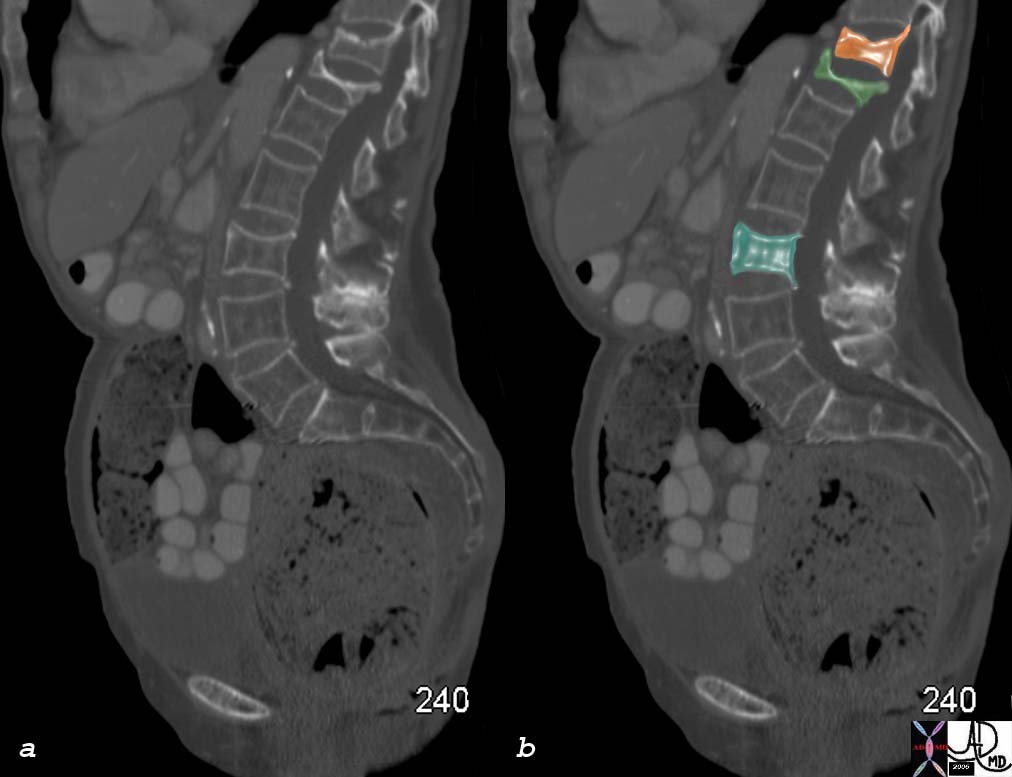 Compression Fractures – mild, moderate, and severe Compression Fractures – mild, moderate, and severe |
| 76123c03 spine bone 86 year old female with severe compression fracture of T12 (green) moderate compression of T11 (orange) and mild compression of L3 (teal) back pain lumbar spine thoracic spine impacted rectum CTscan Courtesy Ashley Davidoff MD |
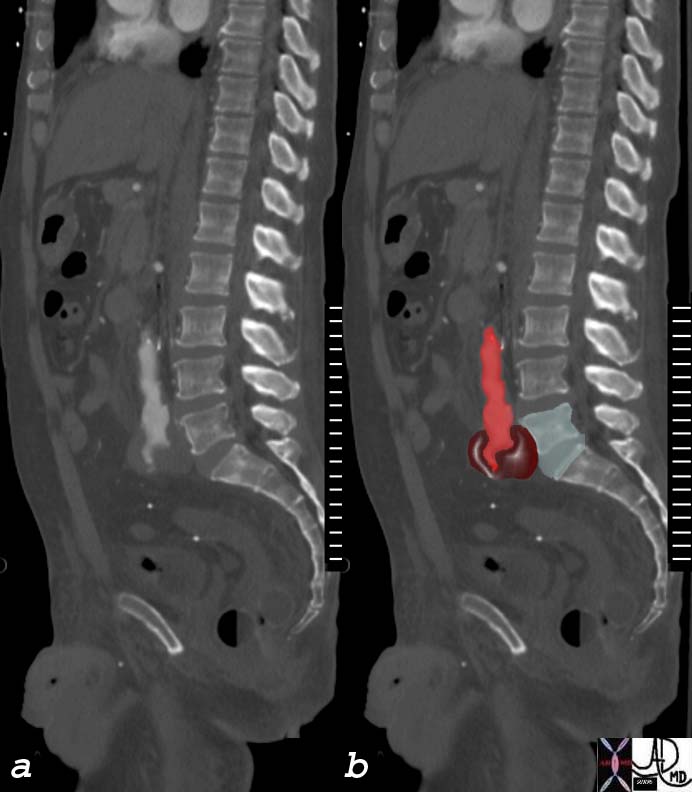 Ruptured Pseudoaneurysm of the Right Common Iliac Artery Ruptured Pseudoaneurysm of the Right Common Iliac Artery |
| 75727c03 elderly man with acute pelvic and back pain aorta iliac artery RLQ right lower quadrant artery pseudoaneurysm ruptured aneurysm retroperitoneal hematoma hemorrhage CTscan Courtesy Ashley Davidoff MD Courtesy Rebecca Schwartz MD 75727c01 75727c02 75724c01 75727c03 |
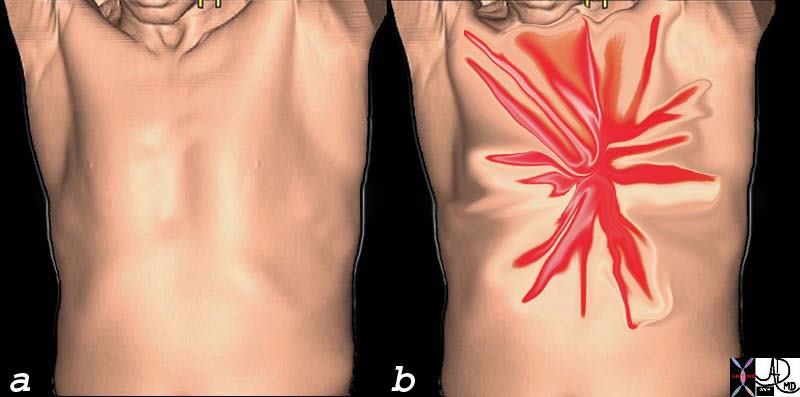 Acute Severe Lancinating, Shearing, Chest Pain of Acute Aortic Syndrome
Acute Severe Lancinating, Shearing, Chest Pain of Acute Aortic Syndrome